Over the years, experience has taught me to be very wary of books about either the history or the philosophy of science written, not by historians or philosophers, but rather by practicing scientists. There are, of course, notable exceptions but such books are often at best questionable and unfortunately oft a total disaster. My caution, potential bullshit antenna set of an alarm when I first stumbled across the advertising for David B. Teplow’s The Philosophy and Practice of Science, but then I noticed that it had a ringing endorsement from Hasok Chang, and I became curious. In my opinion Hasok Chang is a living master of the history of science and if he endorses something then it is worth paying attention, so I asked Cambridge University Press for a review copy and having received one I’m now reviewing Teplow’s tome.
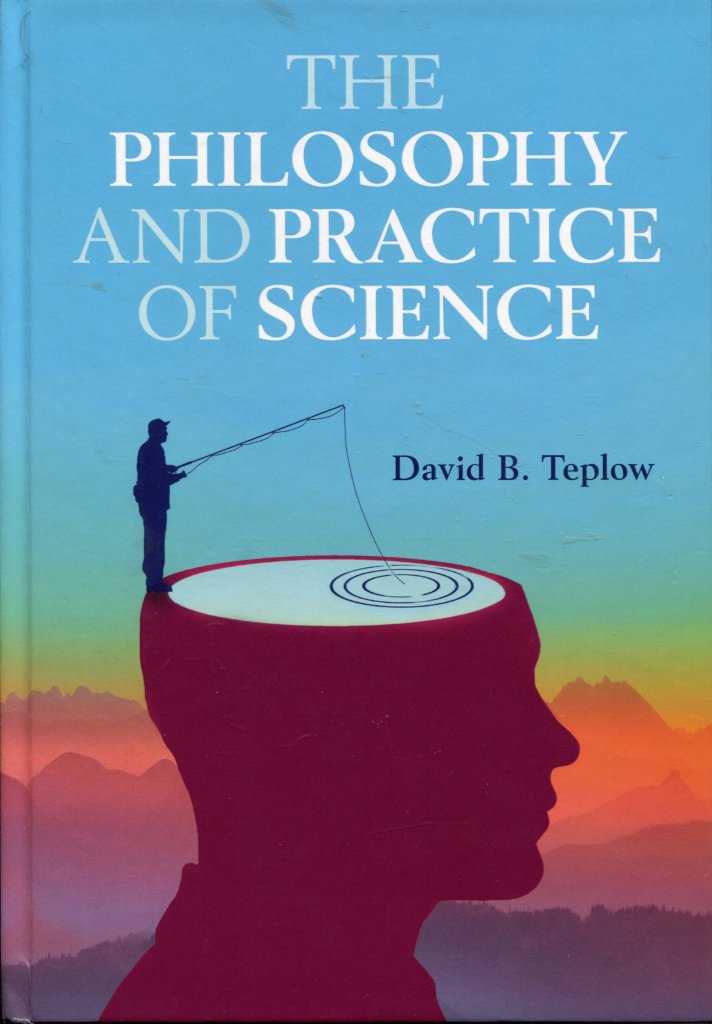
We start off with a general impression, this is a monumental book, by which I’m not referring to its physical dimensions, it’s slightly larger than octavo and has about four-hundred pages. What makes it monumental is the vast amount of detailed information that Teplow has managed to pack into those four hundred pages, which is both its strength and, given its principal intention, its weakness, about which more later. It is a brilliant tour de force into which Teplow has obviously poured his heart and soul, mining to the depths and regurgitating in small portions the 770 papers and monographs that he lists in his bibliography. A process that has taken him a decade since he spent a year at Cambridge University as a visiting scholar in the Department of History and Philosophy of Science under the guiding hand of Hasok Chang with a detailed proposal for the book in his luggage. For all of the energy and scholarship that Teplow has invested in his book it is, unfortunately, from my standpoint as a historian of Early Modern science, at least in one aspect fatally flawed. But I will deal with that later first the positive aspects.
In his preface Teplow writes:
I argue that excellence in scientific practice requires inculcation not only in its empirical form, but also in its historical development, philosophy, and sociology, which the student and scientist should integrate into their design and performance of experiments, interpretation of results, dissemination of findings, and evaluation of the veracity and importance of their work. This is what I consider the “process of science.”
The process of science is this book and this book is the process of science. The manner in which it is written is scientific behaviour, which means thinking deeply and digging deeply. As you read, you will not only be asking questions, but you will also be learning how and why to ask and answer them. [emphasis in original]
He delivers what he promises!
The book is in six sections rather than chapters. The first is the introduction and the second rather short chapter is Defining Science. The following four chapters are elements of Teplow’s process of science and each is divided into subsections and the subsections are divided into subsections, each covering an aspect of the central topic of the section.
The introduction explains Teplow’s motivation for the rest of the book. Having sketched the importance of science in modern society, he explains that if you really want to understand science you need not only to study science but also its history, philosophy, and sociology. Also, this approach should lie at the centre of science education. The main purpose of the book is to explain to young ongoing scientists why, in order to become good scientists, they need to study the history, philosophy, and sociology of science. Here we meet one of Teplow’s favourite devices, tables containing list of the points he is trying to make the second table 1.2 gives twenty-two bullet point answers to the question Why integrate science history, philosophy, and practice? He then explains his programme in the remaining chapters.
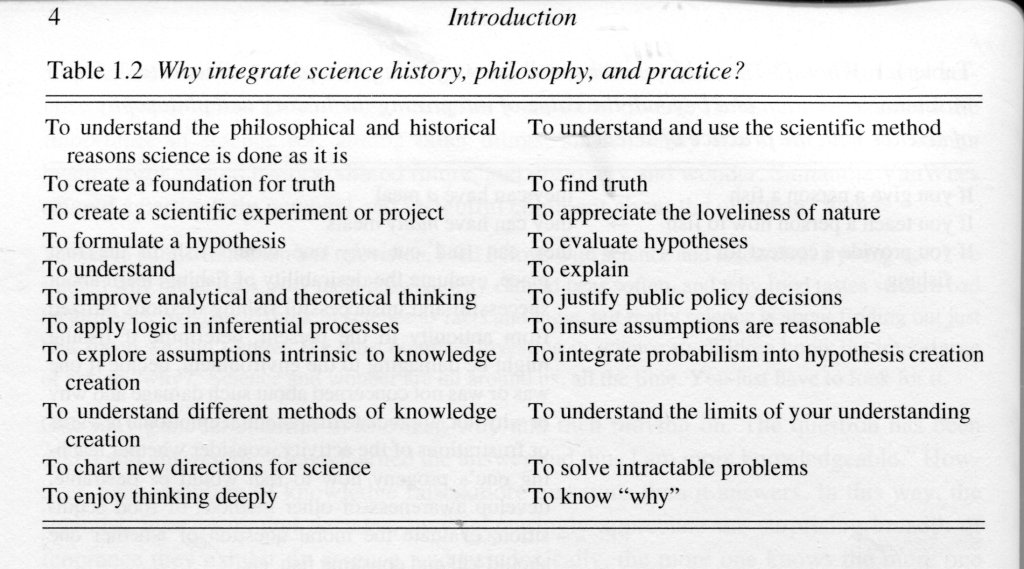
Defining science turns out in Teplow’s hands to be a more than somewhat difficult undertaking. He presents a quite large selection of definitions of science provided by philosophers and scientists and shows how each of them whilst having merits is in some why deficient. Towards the end of the chapter, he writes:
We have seen that many definitions of science have been proffered, each of which may have merit but none of which can define science in the absolute. The scope and complexity of science precludes this. One might thing this puts the idea of science on a weak footing. After all, how can we practice something if we don’t even know what it is? Answer: many forms of science are practiced and this diversity not only is a good thing, but it is one of the most important ways quantum leaps science [sic] are made.
There are two things to note here, this failure to really pin down some aspect of science occurs again and again throughout the book and he explains why this can be viewed as a strength rather than a weakness.
There is one glaring bizarre statement in the chapter that I can’t ignore. Having started the chapter by explaining the science is about knowledge and that the theory of knowledge is epistemology, he then launches his investigation with Aristotle:
Our epistemological quest begins with the Greek philosopher Aristotle (384–322 BC), and interestingly, with the word root of epistemological, epistḗmē (Greek: ἐπιστήμη). In Aristotle’s era, epistḗmē meant knowledge. The word he used for this type of knowledge was scientia, which is the root of the Latin word science.
Of course, Aristotle did not use the word scientia, which is Latin for knowledge and has nothing to do with Greek. The word science, whilst derived from scientia it’s not Latin but according to the etymological dictionary is mid-14c French. How that got past the fact checkers and copyeditors I can’t quite fathom.
The third chapter is titled Learning Science and the first subsection explain why one should learn the history and philosophy of science in order to learn science itself. There is another of Teplow’s tables with a long list of questions about science that can only really be answered with the philosophy and/or history of science.
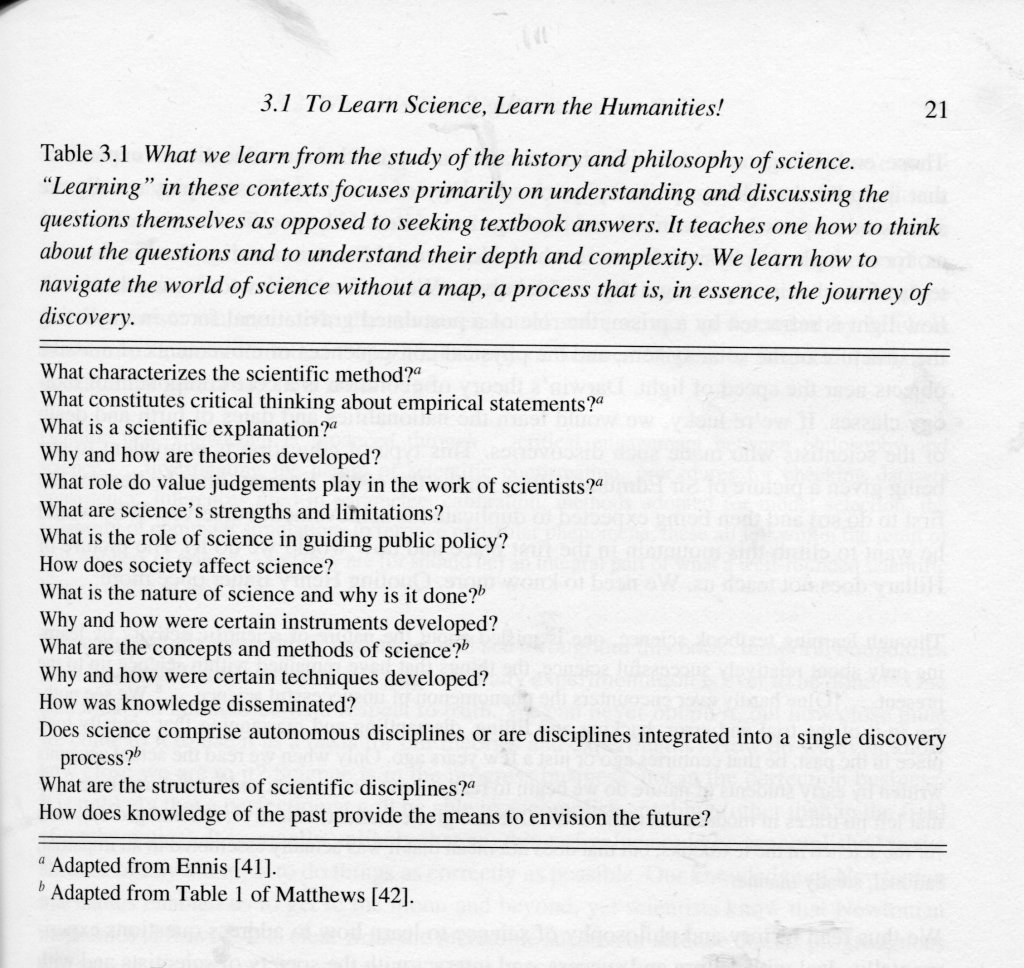
The next section is basically a long list of well known scientific facts, such as the boiling point of water, that on closer examination turn out not to be facts at all. The message being that in science one should look deeply and question everything.
The following section, Scientific Intuition, I found to be somewhat problematic. Teplow say, probably correctly, that if you wish to become a scientist you need a certain undefined feel for the subject, his scientific intuition. I don’t have any real problems with this and I think it applies to any profession. Put trivially, it you don’t like drawing and can’t sketch for toffees than maybe you shouldn’t consider becoming a graphic artist.
It is the next part of this section that worries me. To illustrate his point, he brings short but detailed biographies of the life and work two prominent twentieth-century figures in the life sciences, the biophysicist Max Delbrück (1906–1981 and the biologist Lee Hood (1938). The biographies are very good and both men are truly fascinating and truly exceptional. Unfortunately, because they are so exceptional it tends to confirm the widespread popular misconception than one needs to be some kind of unique genie to become a scientist. You can’t become a physicist if you are not Isaac Newton or Albert Einstein or some combination of both.
US Secretary of Defence, Donald Rumsfeld in a news briefing on 12 February 2002 famously made the following statement:
Reports that say that something hasn’t happened are always interesting to me, because as we know, there are known knowns; there are things we know we know. We also know there are known unknowns; that is to say we know there are some things we do not know. But there are also unknown unknowns—the ones we don’t know we don’t know.
People who couldn’t be bothered to actually think about what he said poured out a great deal of ridicule and scorn at his expense but it is actually a profound analysis and would have made a good chapter heading for the next part of Teplow’s book.
In the pages of the next sections, which are very good, Teplow looks first at knowledge and its acquisition and then ignorance , which, as he correctly points out, is possibly more important in science than knowledge. Science is trying to find answers for the things we don’t know, i.e. of which we are ignorant, rather than simply accumulating lists of things we do know.
Chapter four takes a deep dive into the history of science in an attempt to determine what exactly is the much talked about scientific method. Starting with The Edwin Smith Papyrus (3000–2500 BC), a manuscript on ancient Egyptian medicine, and ending with Paul Feyerabend (1924–1994) and the philosophical rejection of method, Teplow takes us through twenty-five different version of scientific methodology, in somewhat more than seventy pages, covering all the big name. This is on the whole well done although I do have some negative comments. However, before I deal with those, I found his treatment of the nineteenth century–John Herschel, William Whewell, John Stuart Mill, Claude Bernard, William Stanley Jevons–very good, in particular his in depth study of the ideas of Jevons, who tends to get overlooked.
Happily, he includes a section on Ptolemy (c. AD 100–170) which is on the whole very good but then he goes and spoil it with the simple sentence, Ptolemy assumed from the onset, as Aristotle had suggested, that the cosmos was geocentric. When will modern science writers finally learn that if one makes simple empirical observations of the heavens without any prior knowledge, then it is very obvious that we live in a geocentric cosmos. It is the most logical, i.e. scientific, explanation for what one observes.
Teplow observes, quite correctly, that in his optics, Ibn al-Haytham (965–1040) works in a way that is very similar to the way that modern scientist work, quoting other people when making this judgement. However, he fails to note that al-Haytham is working almost identically to Ptolemy in his optics, which whilst praising him for his methodology in astronomy Teplow never mentions, implying that al-Haytham is doing something totally new.
By Al-Biruni we get the classic, “The precision of his astronomical instruments and experimental work is obvious from his determination of the radius of the Earth, 6,339.6 km, which is the same, within experimental error, as that determined by modern scientists (6,356.8–6,378.1 km).” No mention of the fact that it would have been literally impossible for al-Biruni to have made the measurement in the way he describes.
Teplow has a section on Roger Bacon in which he quotes various people disputing that Bacon made a contribution to the scientific method. He quotes the Center for Islamic Studies as follows:
It is absolutely wrong to assume that experimental method was formulated in Europe. Roger Bacon, who, in the west is known as the originator of experimental method, had himself received his training from the pupils of Spanish Moors [my emphasis], and had learnt everything from Muslim sources. The influence of Ibn al-Haitham on Roger Bacon is clearly visible in his works.
Europe was very slow to recognize the Islamic origin of her much advertised scientific (experimental) method. In his book, “The Making of Humanity,”Briffault states,
“It was under their successors at the Oxford School that Roger Bacon learned Arabic and Arabic science. Neither Roger Bacon nor his later namesake has any title to be credited with having introduced the experimental method. Roger Bacon was no more than one of the apostles of Muslim science and method to Christian Europe; and he never wearied of declaring that the knowledge of Arabic and Arabic science was for his contemporaries the only way to true knowledge.To find this ahistorical garbage in a serious book is to say the least stunning. That Roger Bacon was the first European to write about and propagate the optics of al-Haytham is true but that he had received his training from the pupils of Spanish Moors, and had learnt everything from Muslim sources, is total cobblers. Also, as far as I know Bacon did not read Arabic.
After various other medieval philosophers, Teplow delivers an interesting discussion on the other Bacon, Francis and then we arrive at Galileo! Why do rational people lose their marbles as soon as the hear or read the name Galileo and switch into hagiography mode?
“We now come to Galileo Galilei, whose approach to science does make him a father, and maybe even thefather of the scientific method.”
Really? Teplow quotes as confirmation of the highly dubious judgement those leading historians and philosophers of science, Albert Einstein, and Stephen Hawking! Who am I to argue with such authorities?
Teplow tells us Galileo studied mathematics in Pisa. No, he didn’t, he studied medicine and broke off his studies. He received mathematical tuition privately after he had left the university. Teplow has Cosimo II de’ Medici appointing him Chief Mathematician and Philosopher. Chief of what? He was actually court philosophicus and mathematicus. “It was here that Galileo produced his two most famous works Dialogue […] and Discourses […]. In the former work, among other things, Galileo provides arguments supporting the accuracy of the Copernican model of the universe, in contradistinction to the model of Ptolemy.”
In the Dialogo Galileo produces a lot of polemic and hot air but very few real arguments supporting the Copernican model, because he doesn’t really have any. However, Teplow seems to think that we have to maintain the myth. It gets worse.
“Before Galileo, many had argued for the importance of integrating mathematics with observation. Some of these arguments were philosophical in nature and some were applied. However, it was Galileo’s integration of mathematics (including geometry) with experiment, for example, in his validation of the Copernican model of the universe…”
Yer wot? Galileo never validated the Copernican model, he couldn’t and his polemical arguments for the Copernican system featured very little mathematics. In fact, the best mathematical validation for a heliocentric system was Johannes Kepler’s three laws of planetary motion, which Galileo studiously ignored. Love the including geometry! What other mathematics did Galileo use?
I suppose the extensive work of Kepler and Stevin combining mathematics and observation before Galileo somehow doesn’t count. Teplow doubles down on his version of the myth that Galileo introduced mathematics into natural philosophy in his section on the methodology of Isaac Newton. Here he says, “We have also seen that Newton, following Galileo, integrated mathematics into natural philosophy.” There were a very large number of scholars in the seventeenth century using mathematics in natural philosophy between Galileo and Newton, several of whom had a much bigger influence on Newton’s work that Galileo. Teplow compounds his historical ignorance with a footnote to this sentence:
It should be noted, at the time mathematics and natural philosophy were considered two independent fields, the former of which was felt by many to be inferior to the latter, as mathematics was considered the province of engineers and artisans.
Teplow’s claim had been true in the sixteenth century, which is when the division between the two field started to crumble, but by the time Newton wrote the Principia it had been for quite a long time no longer the case.
Of course, Teplow includes the infamous Il Saggiatore quote about the Book of Nature being written in the language of mathematics to justify his claims. He goes completely over the top with his closing quote: Galileo had made “a clear break from the past, deliberately replacing the scientist-philosopher with the mathematical scientist.” A quote from Clavelin M. The Natural Philosophy of Galileo (MIT Press, 1974). You have to ignore an incredible amount that Galileo wrote to believe that. Sublunar comets, theory of the tides anybody?
Teplow delivers good discussions of Descartes, Boyle, and Newton before arriving at the nineteenth century, his discussion of which I have already praised. His discussion of the Logical Positivist and Popper is also acceptable and then we arrive at the scandal child of the philosophy of science, Paul Feyerabend. He gives a reasonably good account of Feyerabend’s anarchistic approach to scientific method and the earthquake it caused within the philosophical and scientific communities but, perhaps, surprisingly ends by viewing Feyerabend’s contribution to the debate positively.
We now arrive at the page that I described in an earlier post as A history of science and technology cluster fuck! The post opens thus:
I don’t remember ever coming across half a paragraph of just nineteen lines that manages to cram in so many history of science and technology myths, errors, and falsehoods as the one that I recently read whilst soaking in a hot bath. A truly monumental cluster fuck!
I’ m not going to repeat it here but if you want to know more, go and read it!
The passage that I dissected there leads into a section on Data-Driven Research the last subsection on the scientific method. In his conclusion, titled, The Scientific Method: Yes, No, Maybe?, Teplow answer is, “Scientific method, in fact, is pluralistic in nature.” Correct in my opinion.
The fifth chapter is actually the heart of the book, having dealt with various aspects of the philosophy of science, Teplow now turn to Science in Practice, in a section that covers 163 of the 350 pages of text in the book. He dissects with a very sharp scalpel every conceivable aspect of actually doing science from choosing a project to the truth, or lack of it, of the theories produced in five sections and twenty-nine subsections. Bringing varying and contrasting views on every topic handled, a master class in in-depth analysis.
If you want to know how science is created and the validity of each step of the process this is the place to turn or is it? However, I have a nagging feeling that Teplow’s thoroughness is to a certain extent self-defeating. In his cover blurb Hasok Chang writes the following:
A veritable intellectual feat including a sweep of the whole history of scientific methodology … [it is] a philosophical manual for working scientists, especially those who are in the early stages of their careers. I hope that generations of students and researchers entering their scientific careers will discover this book and benefit from its abundant wisdom.
Those 163 pages, presenting in quite incredible detail every aspect of scientific practice, are, due to their conciseness and compactness, also incredibly dense and anything but an easy read. I find it hard to imagine the average recently graduated doctoral student or freshly baked post-doc devoting the time and energy to ploughing their way through Teplow’s exhaustive and exhausting analysis. Less and simpler might have been better but I could well be wrong. I for one am not going to offer you an in-depth analysis.
I will, however, draw attention to another couple of Teplow special history claims. In his section Observation⟶Interpretation Having established that Ptolemy grew up in a geocentric world dominated by the cosmology of Aristotle, Teplow writes:
Not surprisingly, Ptolemy’s first model incorporated simple circular orbits of the sun and planets around the Earth. […] To improve the accuracy of the model, Ptolemy implemented epicycles (“orbits within orbits”) within each planets orbital path (deferent), made the Earth eccentric (moved it away from the center of all orbitals) and created an equant, a point offset from the orbital center by an amount equal to the offset of Earth.
Ptolemy’s first model did not incorporate simple circular orbits but incorporated epicycles, deferents and eccenters, which he had inherited from earlier astronomers and mathematicians, from the very beginning. All he added was the equant point.
We then get a version of the misleading diagram that I spent a whole blog post demolishing a couple of years back.
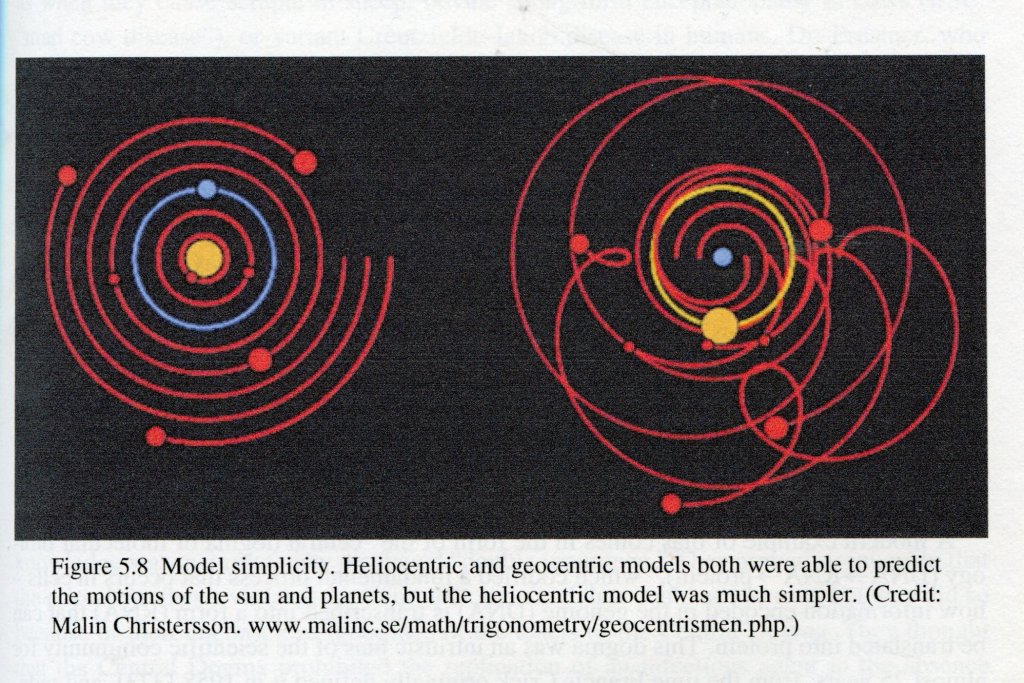
The image on the right is what you actually see from the earth. If you want to see the image on the left you first have to travel outside of the solar system. This is a still from a short video. the original video is on my blog post
After a lot of hogwash about how Ptolemy should have shaken off his ingrained bias and chosen the simple, i.e. heliocentric model, we then get the classic:
Bias imposed on natural philosophers from the public, and especially the Catholic Church, acted to stifle interest in such models and squelch discussion and publication of these models. The Church was particularly sensitive to interpretations of scientific results that produced conclusions contradicting the prevailing theological view that the Earth must be at the center of the universe. One must remember that the suggestion of heliocentricity was heresy, an act that carried heavy legal penalties, including death. Galileo was, in fact charged and convicted of heresy for his confirmation of Copernicus’s results and further promulgation of the idea of heliocentric heavens. [my emphasis]
Regular readers of this blog already now how much rubbish is contained in those few lines but for the sake of any new readers… The Catholic Church only got sensitive about heliocentricity when in 1615, Galileo and Paolo Antonio Foscarini started telling it how to interpret the Bible, not a wise thing to do in the middle of the Reformation/Counter Reformation. Scholars were free to discuss or publish these models as long as they treated them hypothetically their actually scientific status at the time, and not as established fact. The suggestion of heliocentricity was never formally declared heretical, to claim otherwise is a myth. Galileo was not charged with heresy but with breaching a Church injunction not to hold or teach the theory of heliocentricity (as fact). He was found guilty of grave suspicion of heresy and not heresy, a completely different offense. Galileo in no way confirmed Copernicus’ result, he wasn’t able to. What results? Copernicus published a hypothesis, which was unsupported by the available empirical facts at the time.
The final chapter or section of the book is as its title, Science as a Social Endeavour, suggests a brief tour of the sociology of science. A positive aspect of the book as science is all too often handled as if it takes place in some sort of intellectual vacuum. After some interesting discussions on the role, function, and status of practicing scientists in a social context.
Unfortunately, Teplow once again displays his ignorance of pre-modern science. He provides one of his tables with the title Issues about which truth and opinion collide.
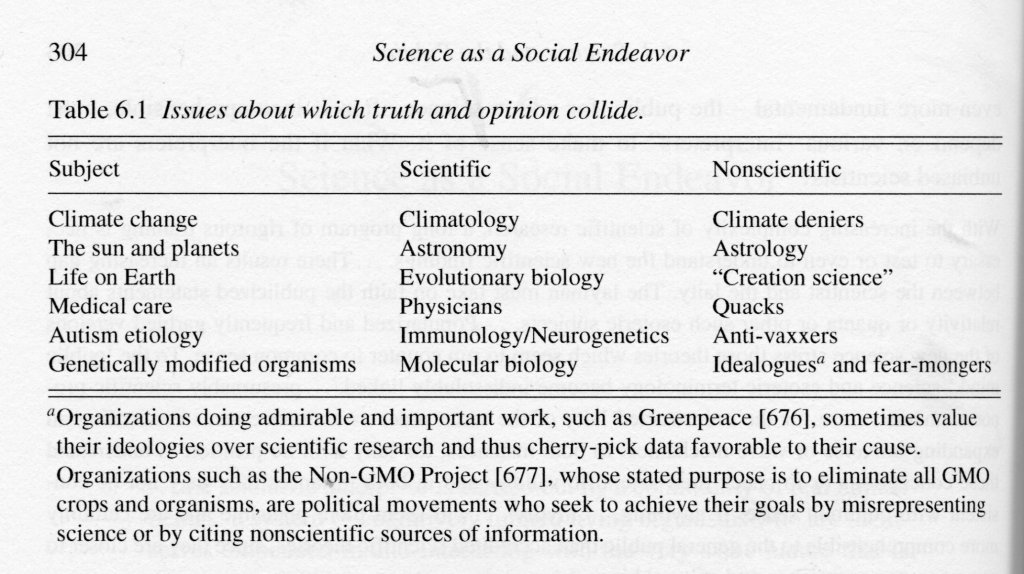
This is an important aspect of the sociology of science and in general Teplow handles it well, dealing with the conflicts between science and pseudo-science quite extensively.
Five of his examples are classical science contra non-scientific with an either/or, either you accept the science or you reject it and believe in some sort of non-scientific hogwash. However, the situation with astronomy and astrology is totally different. To quote myself from an essay I wrote for the Forbidden Histories website:
Over a period of something between three and four thousand years, astronomy and astrology were not rivals or competitors but two sides of the same coin, Siamese twins joined at the hip only separated in the final phases of the so-called scientific revolution.
[…]
Ptolemy wrote [in his Tetrabiblos] that the science of the stars has two aspects, one that determines the position of the stars and the other that determines their influence. We would call the first astronomy and the second astrology…
Teplow justifies his inclusion of the pair astronomy/astrology in a footnote:
It is interesting, but not surprising that the same type of pseudo-scientific tripe was expounded by astrologers [who were also the astronomer, which Teplow doesn’t mention] in the eleventh century. However, what is very surprising that even then, some natural philosophers, such as the famous Islamic scholar al-Biruni, condemned this pseudo-science. Referring to astrologers, al-Biruni wrote”… [they] would stamp the sciences as atheistic, and would proclaim that they lead people astray to make ignoramuses, like him, hate the sciences and scientists. For this will help him conceal his ignorance, and to open the door for the complete destruction of both science and scientists.” (see Chapter 6, al-Biruni-On the Importance of the Sciences, in Levi, Islamic Central Asia : An Anthology of Historical Sources (Indiana University Press , 2010)).
It is clear from the context that al-Biruni is referring to one individual (him, his) so I don’t why Teplow has written “they,” also the objections of the unknown critic appear to be theological rather than astrological. I’m not going to go into it here but al-Biruni’s views on the practice of astrology are much more complex and he even wrote a book on astrology:
The Tafhīm. A manual of instruction in astrology, well over half of the book is taken up with preliminaries to the main subject. Persian and Arabic versions are extant, both apparently prepared by Bīrūni himself. It is arranged in the form of questions and answers. There are five chapters in all, the first (thirty-three pages in the Persian edition) on geometry, ending with Menelaus’ theorem on the sphere. The second (twenty-three pages) is on numbers, computation, and algebra. Chapter 3, the longest (229 pages), deals with geography, cosmology, and astronomy. From it a complete technical vocabulary may be obtained, as well as sets of numerical parameters, some of them uncommon. The next chapter (thirty-one pages) describes the astrolabe, its theory and application. Only the last chapter (223 pages) is on astrology as such, but it is complete and detailed. (E. S. Kennedy, DSB)
The Tafhīm is regarded by historians of Islamic astrology as one of the best explanatory texts on the topic. So, Teplow’s quote is not quite the slam-dunk that he thinks it is.
Teplow closes his book with a subsection, The Progress of Science: Paradigms, Research Programmes, and Traditions, which looks at the philosophy of science theories of Thomas Kuhn, Imre Lakatos, and Larry Laudan respectively. The accounts are brief, possibly too brief. For my taste his account of Kuhn’ Paradigms is too benevolent and I don’t think he has really understood Lakatos’ Research Programmes. I can’t really comment on his analysis of Laudan’s work as I’ve never read it.
Teplow’s book is illustrated with a fairly large number of his tables, various diagrams. and some pictures. On the subject of footnotes, he writes at the end of the preface:
One need not read all 777 footnotes, but I encourage the reader to patiently take the time to do so because footnotes reveal interesting and surprising thinks not generally taught to students not known by even the most accomplished practicing scientists.
The book doesn’t have a bibliography in the normal sense but a consecutively numbered list of 770 references that are numbered in the sequence in which they appear in the text. A quote or a text summary in the text is then simply referenced with a number, [555] for example. There is a very skimpy and as I discovered relatively useless index. A couple of time I found historical examples, like the ones I have criticised above, and neglected to note where they were, thinking I could find them again in the index! No chance!
Despite all of the negative comments in my review I actually think this is a very good book. The majority of the history of science examples that Teplow brings are from comparatively recent areas of the biological sciences, where he is personally at home. These are as far as I can judged well researched and accurate. However, as I have illustrated he lets himself down with the very poor quality of his references to earlier eras of the history of science. Otherwise, the book has lots of valuable information for those who wish to understand the process of science, all of which is assiduously researched and presented. Personally, I think it is too compact, too dense, and simply too much for the average ongoing young scientist to sit down and plough their way through it. However, I think, with the historical errors corrected, it would make an excellent textbook for a half or even a full year course for ongoing scientists and I personally have long thought that such a course should be part of the education of every ongoing scientist.